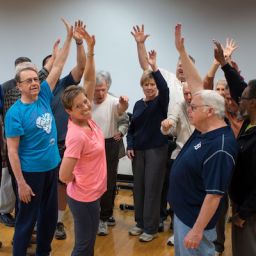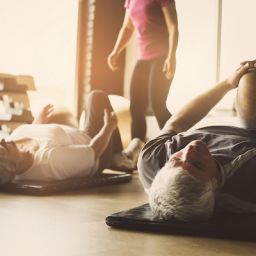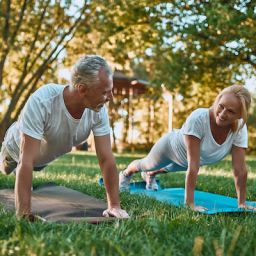You know you need physical therapy, but you can’t find Parkinson’s therapy near you.
Now what?
Is there anything you can do on your own to address some of the balance, gait, or posture issues you’ve noticed starting to creep up on you?
The honest truth is that nothing matches the benefits of being seen by a skilled Parkinson’s physical therapist. Similar to how your neurologist knows how to customize your medication profile based on your symptoms, a physical therapist is able to tailor your exercise program to address your individual symptoms and catch minor issues before they become a major concern.
The good news, however, is that you can still make a lot of progress on your own that will help ease your symptoms and slow the trajectory of your experience with Parkinson’s.
In this article, we’ll share five ways you can start to build a movement foundation so that when you’re able to see a physical therapist, you’ll be starting from a place of strength.
5 Ways to Get a Jump Start on Parkinson’s Physical Therapy
Parkinson’s physical therapy exercises incorporate a variety of strengthening, flexibility, balance, and coordination components based on your unique set of symptoms. Since every person diagnosed with Parkinson’s is different, it’s impossible to recommend one type of exercise.
However, everyone benefits from moving, and there are five basic strategies you can use to build your “movement foundation”.
#1 – Hydrate
One of the best things you can do to improve your movement is to hydrate properly. If you’re dehydrated, you’re not getting nearly enough bang for your exercise buck. Staying hydrated improves joint and muscle elasticity, helps regulate blood pressure, and boosts energy levels, which in turn improves your ability to exercise regularly.
Goal: Drink ½ your bodyweight (lbs) in ounces of water. (i.e., a 120-pound woman needs 60oz of water per day)
#2 – Breathe
Improving your lung function will not only improve your energy, endurance, and ability to exercise but also your ability to speak strongly, swallow, and cough more effectively. Fortunately, you don’t have to have any equipment to improve your lung function! You can practice using this introductory breath flow during PWR!®Moves with Speech and Language Pathologist, John Dean, or find a SPEAK OUT! provider in your area. Singing is also a wonderful way to strengthen your lungs, so go ahead and belt it out like Whitney Houston!
Goal: Five to 10 minutes per day, seven days a week.
#3 – Focus on Flexibility
Most people overlook flexibility training; however, when muscles are too tight, they can’t contract the way you need them to. In other words, tight muscles are weak muscles. When you focus on stretching regularly through your full, pain-free range of motion, you’ll notice your daily tasks and exercise program are easier and more fluid. Yoga, pilates, and tai chi are all excellent choices to improve your flexibility. Also, check out our 4-part in-home core strengthening series for a variety of Parkinson’s flexibility exercises to improve your posture and spinal mobility.
Goal: Twenty minutes per day, five days a week.
#4 – Get Your Heart Rate Up
There is ample evidence to support the notion that engaging in regular moderate-intensity aerobic exercise helps to slow the progression of Parkinson’s. Fortunately, there are a variety of ways to increase your heart rate and work up a sweat, regardless of ability level.
- Walking is a fantastic place to start, adding in walking poles (like these from UrbanPoling) as desired.
- Biking is a great low-impact option. You can cycle outdoors or indoors on a stationary bike. The TheraCycle is a motor-assisted bike that could be a good option for someone with symptoms that limit their ability to cycle.
- Swimming is an excellent aerobic workout, as well as water aerobic classes.
Goal: Thirty minutes per day, five days a week.
#5 – Find Your Community
Did you know that loneliness is a significant predictor of Parkinson’s progression? That’s right. A lack of connection with others can completely negate your entire exercise routine. Some have gone so far as to argue that if you’re exercising six days per week, 30 minutes at a time, and yet you feel lonely and disconnected most of the time, it’s a wash. Getting involved with your community, having lunch with a friend, or volunteering once a week can keep your spirits high and keep you out of the downward spiral that sometimes derails your best exercise intentions.
Goal: Connect with at least one other person, face-to-face, at least four days per week. Also, be sure to sign up for our upcoming webinar on the power of social connection with Dr. Al Condeluci on Wednesday, April 15, 2020, here.
Finally, don’t make this mistake…
We’ve just walked you through five ways to get a jump start on physical therapy, even when you don’t have a Parkinson’s therapist close by. However, these pillars do not replace seeing a skilled therapist. The biggest mistake we see people in our community make is that they never go see a physical therapist, thinking they’re getting the same thing with a few fitness classes or their home stretching routine.
One of the most recited lines we hear people say is, “I wish I would have seen a Parkinson’s physical therapist sooner!” Even if it’s a bit of a commute to see a Parkinson’s physical therapist in the next town over, make the commitment.
Want More Practical Articles Like This?
Much more can be found in our latest edition of Davis Phinney Foundation’s Every Victory Counts® manual. It’s packed with up-to-date information about everything Parkinson’s, plus an expanded worksheets and resources section to help you put what you’ve learned into action. Request your copy of the Every Victory Counts manual by clicking the button below.

















